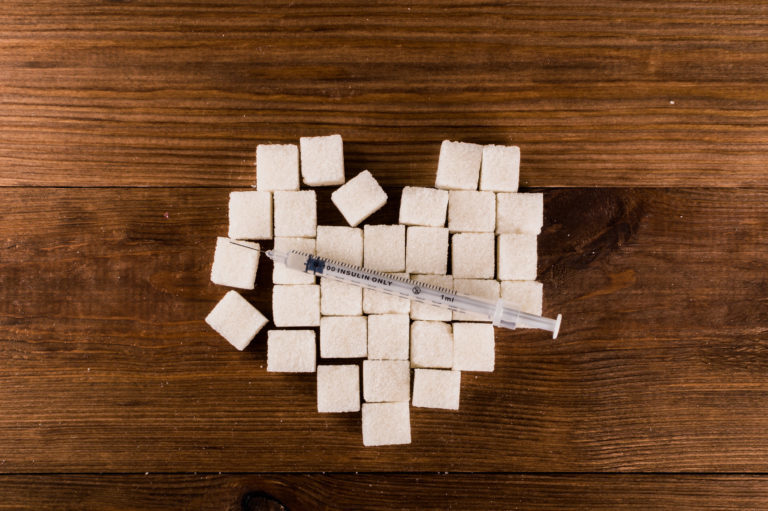To understand the adverse effects of sugars-sucrose, high-fructose corn syrup, and other fructose-rich sweeteners, such as agave, honey, and maple syrup-we need to understand two phenomena:
- Insulin resistance
- Glycation
When blood sugar rises, insulin is released by the pancreas. Repeated over and over again, the cells of the body fail to respond to the insulin; they become "insulin resistant." This leads to further rises in blood sugar and inflammatory responses, failure to respond to normal appetite signals, and growth of visceral (deep abdominal) fat. The cells of the body-deprived of glucose for energy due to the failure of insulin (which allows entry of glucose into cells)-resort to fat and protein for energy, resulting in rises in blood triglycerides from fats released into the bloodstream, along with loss of muscle.
The essential first step that creates insulin resistance is therefore a rise in blood sugar. Any rise in blood sugar above fasting levels (90 mg/dL) will, over time, provoke insulin resistance: The higher the blood sugar and the more frequently it occurs, the more insulin resistance is provoked. Fructose worsens the effect: inflammation, growth of visceral fat, increased blood triglycerides and fatty acids, and fatty liver-all powerful blockers of insulin that worsen insulin resistance.
The conventional medical solution? Sugar "in moderation," increased whole grain consumption, lots of low-fat foods-disastrous dietary advice, followed by drugs that come to our "rescue,"handily explaining why the diabetes drug industry is growing at unprecedented rates along with booming executive salaries.
The Undoctored solution? Eliminate foods that start the process in the first place. If we eliminate foods that send blood sugar and insulin to high levels, the entire collection of abnormalities reverse. We also slash fructose intake to only fruit-no high-fructose corn syrup or other sources. Yes, do the opposite of conventional dietary advice and eat no "healthy whole grains," don't restrict fats but increase their consumption, and never rely on low-fat or other fructose-containing foods.
While most people are able to reverse blood sugar and insulin levels back to normal, also undoing insulin resistance and diabetes, some people have progressed so far down this path and have irreversibly damaged beta cells of the pancreas that produce insulin (high blood sugars and high triglycerides damage the pancreas). People in this situation may not return to normal. This situation is suggested by failure to enjoy fasting blood sugars of 70 to 90 mg/dL after ideal weight is achieved and despite doing everything else right. Drugs may indeed be helpful in this uncommon situation. The key is to therefore follow this lifestyle before pancreatic beta cell damage sets in.
Glycation
Glycation refers to the glucose- and fructose-modification of proteins that occurs when glucose or fructose levels increase, a reaction between sugar and body proteins. Glycation occurs at a natural low rate just from normal blood sugar levels, even while fasting, but it occurs at increasingly greater rates with any rise in blood sugar above 90 mg/dL.30 Primitive people had limited exposure to sugars: seasonal fruit, tropical fruit in some environments, honey. They certainly did not have around-the-clock, everyday access to sweetened foods and soft drinks, nor were they advised by government agencies to load up on amylopectin-containing grains. It means that modern sugar consumption, made worse by the grain domination of the modern diet, exposes you to repetitive waves of protein glycation.
Once it occurs, the glycation reaction is irreversible. Glycation alters the properties of proteins, making them nonfunctional, essentially creating cellular debris that gums up the function of whatever organ they reside in, much like rust interferes with smooth functioning of the gears in a motor.
All of this has serious health consequences:
- If glycation of the proteins of the lenses of the eyes develops, opacities accumulate, leading to cataracts.
- Glycation of skin proteins gives you brown-colored "age spots" and wrinkles.
- Glycation of cartilage proteins makes cartilage brittle, eroding and leading to inflammation and the pain of arthritis.
- Glycation of kidney tissue leads to declining kidney function.
- Glycation of LDL particles in the bloodstream makes them more likely to contribute to atherosclerosis (heart disease).
- Glycation of brain proteins contributes to dementia.
You may recognize the phenomena of glycation as sounding an awful lot like the phenomena of aging, reflected in the advanced glycation end-product, or AGE, theory of aging. Yes, to a substantial degree, aging is a consequence of diet that proceeds faster due to sugars and grains, regardless of whether they are "organic," "sprouted," or any other label designed to pull your attention away from the sugar.
Any time blood sugar rises above normal, glycation occurs at an accelerated rate. What foods raise blood sugar the most, triggering the greatest degree of glycation? Grains and sugar. Gluten-free foods made with cornstarch, tapioca starch, potato starch, and rice flour are guilty of the same. And whatever you do, don't be tricked by talk of "low glycemic index."
The Undoctored solution is to stop overstimulating the processes of glycation or fructation in the first place by eliminating, or at least managing, all the foods that are responsible for these reactions. Removing the appetite-stimulating effects of wheat and grains via gliadin-derived opiates also helps bring the feeding frenzy of sugar in all its various forms to a halt.




Comment: Why sugar is called the 'White death'